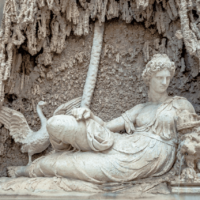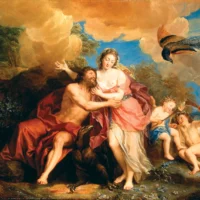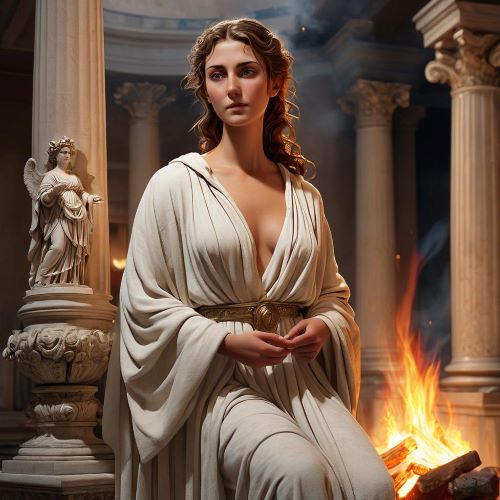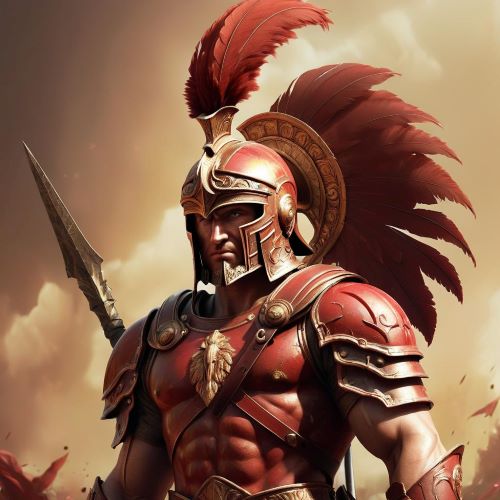Juno : Queen of Olympus
Listen
Juno
Introduction
Juno, also known as Iuno in Latin, held a significant position in ancient Roman mythology as a goddess revered for her role as the protector and advisor of the state. She was equated with Hera, the queen of the Greek gods, and revered as a deity associated with love and marriage. As the patron goddess of Rome and the Roman Empire, Juno was honored with the title Regina (“Queen”) and formed part of the Capitoline Triad, which included Jupiter and Minerva, emphasizing her importance in the religious and civic life of Rome.
Depicted frequently as the queen of the gods, Juno’s influence spanned from celestial realms to earthly matters. Revered as the queen of the Roman pantheon, Juno’s significance extended far beyond her role as the consort of Jupiter, the king of gods. She held a multifaceted position as a powerful guardian of women, marriage, childbirth, and the well-being of the Roman state.
Physical Traits
Juno is depicted in various forms, often as a stately matron of imposing stature and striking beauty, sometimes with martial attributes. She is commonly portrayed as a regal and graceful figure adorned with a crown and holding a scepter. Similar to Hera, Juno’s favored creature is the peacock. Roman artwork typically presents Juno as a mature and commanding woman, frequently adorned with a diadem, a jeweled headband symbolizing her royal standing. She is often depicted in flowing white attire, emphasizing her purity and association with marriage.
Additionally, the majestic peacock, known for its vibrant feathers, is emblematic of Juno. However, Juno’s representations are not confined to elegance alone. In her role as protector of Rome, especially in times of conflict, she may appear in a goatskin cloak wielding a spear and shield, reminiscent of the warrior goddess Athena from Greek mythology. This duality in her portrayal reflects the multifaceted nature of her character—a formidable goddess capable of nurturing care and fierce defense.
Family
Juno’s lineage is central to the Roman pantheon, rooted in illustrious parentage. She was born to Saturn, the god of time, and Ops, the goddess of fertility. Among her siblings were Vesta, the goddess of the hearth, Ceres, the deity of agriculture, Pluto, ruler of the underworld, Neptune, lord of the sea, and Jupiter, her husband and brother. Through her marriage to Jupiter, she ascended to the throne as queen of the gods and mothered several prominent deities, including Mars, the god of war, Vulcan, master of fire and metalworking, Bellona, the goddess of war, and others.
The relationship between Juno and Jupiter was intricate and far from harmonious. Despite her elevated status as queen, Jupiter’s frequent infidelities fueled Juno’s resentment and jealousy, echoing the turbulent union of Zeus and Hera in Greek mythology. This divine drama underscores the complexities and conflicts within the Roman pantheon, revealing Juno’s pivotal role as both spouse and rival to the king of gods.
Other names
Juno, a central figure in Roman mythology, was revered under numerous epithets and titles that encapsulated her multifaceted roles and attributes. Among these, she was known as Juno Regina, emphasizing her prestigious position as the queen of the gods and the Roman state. This title highlighted her sovereignty and authority over celestial and earthly affairs, reflecting her status as a divine matriarch within the pantheon. Additionally, Juno Moneta represented her role as a protector and advisor, particularly associated with matters of finance and monetary stability. The name “Moneta” itself derived from Juno’s connection to the Roman mint, emphasizing her association with wealth and prosperity.
Another significant epithet, Juno Lucina, highlighted her role as a guardian of women during childbirth and symbolized the nurturing aspect of her character. Temples dedicated to Juno Lucina served as sanctuaries where expectant mothers sought her protection and assistance for safe deliveries. This aspect of Juno underscored her importance in safeguarding the continuity of life and the well-being of families. Meanwhile, Juno Sospita was revered as a warrior goddess, especially in the city of Lanuvium, where she was depicted wielding weapons like a spear and shield, symbolizing protection and liberation from harm.
Juno’s diverse epithets reflected the breadth of her influence in Roman society, encompassing various aspects of life, from governance and finance to childbirth and protection. As Juno Matrona, she embodied the virtues of Roman womanhood, representing wifely devotion and maternal care. These epithets collectively emphasized Juno’s complex and dynamic persona, showcasing her roles as a sovereign queen, a nurturing guardian, and a formidable protector. Juno’s enduring significance in Roman culture was intertwined with these epithets, each adding layers of meaning to her divine character and reinforcing her pivotal role within the Roman pantheon.
Powers and Abilities
Juno, reigning as the queen of the gods in Roman mythology, wielded formidable power over various aspects of life. Her dominion extended beyond the celestial realm, encompassing control over storms, the outcome of battles, and even the thoughts of both mortals and immortals. Her association with women granted her authority over marriage, childbirth, and other feminine facets of existence, underscoring her influence in matters of life and destiny.
Renowned for her cunning intellect and strategic acumen, Juno frequently orchestrated intricate schemes to counter Jupiter’s infidelities and exact revenge upon her adversaries. These calculated maneuvers solidified her reputation as a commanding and astute deity, capable of outwitting even the most powerful figures in the pantheon. As guardian of marriage and family, Juno held pivotal sway over fertility, childbirth, and the well-being of women, fulfilling her divine role with authority and vigilance.
Juno’s divine portfolio extended beyond familial and civic domains, encompassing the ability to shape-shift and assume various forms to interact with mortals and fellow deities. She was also attributed with control over weather patterns and the skies, as symbolized by the peacock, an emblem of immortality and celestial realms. Furthermore, Juno’s role as a goddess of marriage bestowed upon her the power to bestow fertility, love, and enduring commitment upon couples. Her influence over childbirth and motherhood further emphasized her role as a protector and nurturer within the Roman pantheon, highlighting her multifaceted and commanding presence in the divine hierarchy.
Modern Day Influence
Juno’s profound influence persists across diverse facets of modern culture, inspiring artistic expressions that range from classical sculptures to contemporary paintings. Her portrayal as a devoted wife and mother has served as an archetype in numerous artistic interpretations, resonating with themes of familial devotion and maternal strength. Additionally, Juno’s symbolism as a protector of women’s rights and dignity reverberates within feminist discourse, challenging conventional gender norms and advocating for empowerment in contemporary society.
Furthermore, Juno’s lasting impact is evident in the realm of astronomy, particularly with the NASA spacecraft “Juno,” launched in 2011 to explore Jupiter and its mysteries. This cosmic endeavor not only pays tribute to the Roman goddess but also underscores the enduring allure of mythological figures like Juno, whose timeless significance continues to captivate our collective imagination and understanding of the divine.
In addition to the arts and sciences, Juno remains a prominent figure in literature and popular culture. Her image frequently adorns paintings, sculptures, and literary works that explore themes of marriage, feminine empowerment, and divine authority. Juno’s representation has also been adopted by feminist movements as a symbol of female strength and independence. Moreover, modern media platforms such as movies, television shows, and video games often reference Juno, showcasing her enduring relevance and multifaceted character in contemporary storytelling and entertainment.
Related Images
Frequently Asked Questions
What is lorem Ipsum?
I am text block. Click edit button to change this text. Lorem ipsum dolor sit amet, consectetur adipiscing elit. Ut elit tellus, luctus nec ullamcorper mattis, pulvinar dapibus leo.
What is lorem Ipsum?
I am text block. Click edit button to change this text. Lorem ipsum dolor sit amet, consectetur adipiscing elit. Ut elit tellus, luctus nec ullamcorper mattis, pulvinar dapibus leo.
What is lorem Ipsum?
I am text block. Click edit button to change this text. Lorem ipsum dolor sit amet, consectetur adipiscing elit. Ut elit tellus, luctus nec ullamcorper mattis, pulvinar dapibus leo.
What is lorem Ipsum?
I am text block. Click edit button to change this text. Lorem ipsum dolor sit amet, consectetur adipiscing elit. Ut elit tellus, luctus nec ullamcorper mattis, pulvinar dapibus leo.
What is lorem Ipsum?
I am text block. Click edit button to change this text. Lorem ipsum dolor sit amet, consectetur adipiscing elit. Ut elit tellus, luctus nec ullamcorper mattis, pulvinar dapibus leo.












